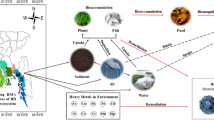Abstract
The potential sources of tritium in the Yenisei River ecosystem are global pollution of the environment and the functioning of the Mining and Chemical Combine (MCC), Rosatom State Corporation. The background tritium content of zoobenthos, bottom sediments, some commercial fish species, and the most widely occurring aquatic plant species was determined for the first time. The MCC functioning affected the tritium content in the nearest impact zone, and significant excess of the tritium content of aquatic plants over the background level was revealed.
Similar content being viewed by others
References
Environmental Isotope Data: World Survey of Isotope Concentration in Precipitation, Vienna: IAEA, 1979.
Katrich, I.Yu., Tritium monitoring in natural waters of the USSR (Russia), Doctoral (Geogr.) Dissertation, Moscow, 2009.
UNSCEAR Document A/AC.82/R.360: Contamination from Nuclear Explosions, UNSCEAR, March 1979.
Radiation: Doses, Effect, Risks, UNEP, 1985.
Sources, Effects, and Risks of Ionizing Radiation: United Nations Scientific Committee on the Effects of Atomic Radiation 1988 Report to the General Assembly, with Annexes, New York: UN, 1988.
The Tritium Systems Test Assembly at the Los Alamos National Laboratory, Los Alamos National Security, Benefits LANL, NNSA & National Security, DOE, 2002. 36 p.
Report and Advice on the Ontario Drinking Water Quality Standard for Tritium, Toronto: Ontario Drinking Water Advisory Council, 2009. 67 p.
Weinberg, A.M., Phys. Today, 1981, vol. 34, no. 3, pp. 48–56.
Chebotina, M.Ya. and Nikolin, O.A., Radioekologicheskie issledovaniya tritiya v ural’skom regione (Radioecological Studies of Tritium in the Ural Region), Yekaterinburg: Ural’skoe Otdel. Ross. Akad. Nauk, 2005.
Bondareva, L., Fusion Sci. Technol., 2011, vol. 60, no. 4, pp. 1304–1307.
Bolsunovsky, A.Ya. and Bondareva, L.G., J. Environ. Radioact., 2003, vol. 66, pp. 285–294.
Bolsunovskii, A.Ya. and Bondareva, L.G., Ekologiya, 2005. no. 1, pp. 59–63.
Tritium Measurement Techniques: Report no. 47 of the National Council on Radiation Protection and Measurements, USA: NCRP, 1976.
Tolhurst, T.J., Reithmüller, R., and Paterson, D.M., Contin. Shelf Res., 2000, vol. 20, pp. 1317–1334.
Bondareva, L.G. and Pomozova, N.V., Zh. Sib. Fed. Univ., Khim., 2009, vol. 2, no. 1, pp. 56–60.
Osnovy radiokhimii i radioekologii. Prakticheskie raboty (Principles of Radiochemistry and Radioecology. Practical Works), Afanasov, M.I., Ed., Moscow: Mosk. Gos. Univ., 2012.
Nosov, A.V. et al., At. Energy, 2001, vol. 90, no. 1, pp. 91–94.
Ivanitskaya, M.V. and Malofeeva, A.I., Sources of tritium ingress into the environment, Tritii–eto opasno (Tritium: It Is Dangerous), Chelyabinsk, 2001. pp. 22–29.
Makhon’ko, K., Kim, V., Kozlova, E., et al., Byull. At. Energ., 2001. no. 10, pp. 26–43.
Bondareva, L.G., Radiochemistry, 2012, vol. 54, no. 1, pp. 98–104.
Bondareva, L., Zeer, G., Gerasimov, V., and Zhizaev, A., River Syst., 2012. vol. 20, nos. 3–4, pp. 149–156.
Zuev, I.V., Semenova, E.M., Shulepina, S.P., et al., J. Sib. Fed. Univ., Biol., 2011. no. 4, pp. 281–292.
Garston, A.L., Adv. Radiat. Biol., 1979. vol. 8, p. 419.
Boyer, C., Vichot, L., Fromm, M., et al., Environ. Exp. Bot., 2009, vol. 67, no. 1, pp. 34–51.
McCubbin, D., Leonard, K.S., Bailey, T.A., et al., Marine Pollut. Bull., 2001, vol. 42, no. 10, pp. 852–863.
Yankovich, T.L., Kim, S.B., Baumgärtner, F., et al., J. Environ. Radioact., 2011, vol. 102, no. 1, pp. 26–34.
Author information
Authors and Affiliations
Corresponding author
Additional information
Original Russian Text © L.G. Bondareva, 2015, published in Radiokhimiya, 2015, Vol. 57, No. 5, pp. 475–480.
Rights and permissions
About this article
Cite this article
Bondareva, L.G. Tritium content of some components of the middle Yenisei ecosystem. Radiochemistry 57, 557–563 (2015). https://doi.org/10.1134/S1066362215050197
Received:
Published:
Issue Date:
DOI: https://doi.org/10.1134/S1066362215050197




